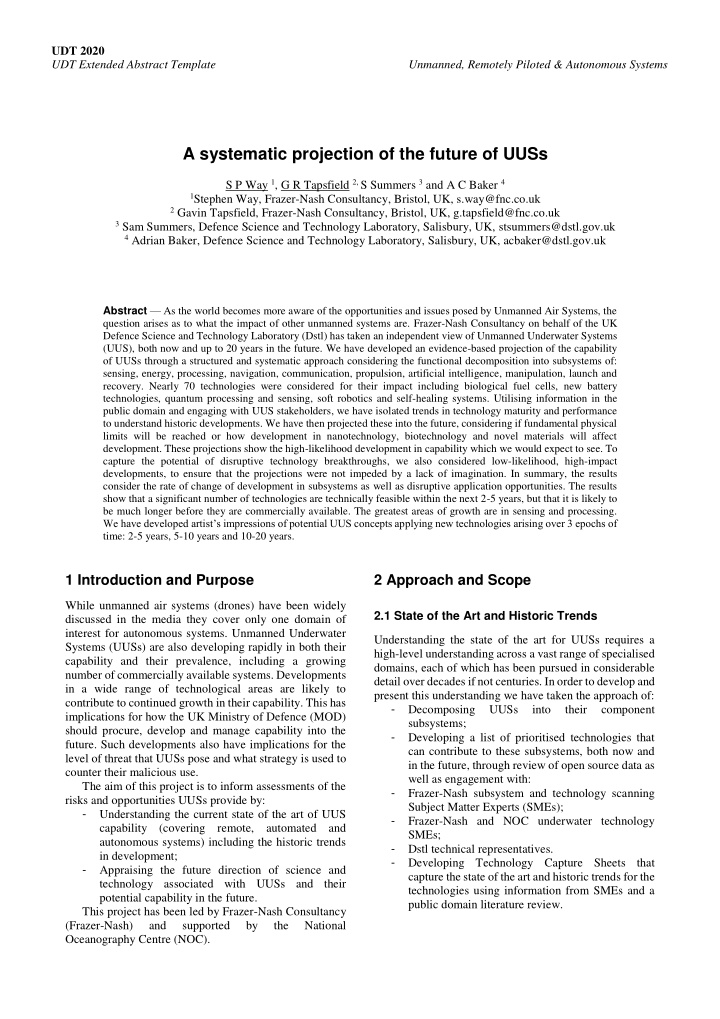



UDT 2020 UDT Extended Abstract Template Unmanned, Remotely Piloted & Autonomous Systems A systematic projection of the future of UUSs S P Way 1 , G R Tapsfield 2, S Summers 3 and A C Baker 4 1 Stephen Way, Frazer-Nash Consultancy, Bristol, UK, s.way@fnc.co.uk 2 Gavin Tapsfield, Frazer-Nash Consultancy, Bristol, UK, g.tapsfield@fnc.co.uk 3 Sam Summers, Defence Science and Technology Laboratory, Salisbury, UK, stsummers@dstl.gov.uk 4 Adrian Baker, Defence Science and Technology Laboratory, Salisbury, UK, acbaker@dstl.gov.uk Abstract — As the world becomes more aware of the opportunities and issues posed by Unmanned Air Systems, the question arises as to what the impact of other unmanned systems are. Frazer-Nash Consultancy on behalf of the UK Defence Science and Technology Laboratory (Dstl) has taken an independent view of Unmanned Underwater Systems (UUS), both now and up to 20 years in the future. We have developed an evidence-based projection of the capability of UUSs through a structured and systematic approach considering the functional decomposition into subsystems of: sensing, energy, processing, navigation, communication, propulsion, artificial intelligence, manipulation, launch and recovery. Nearly 70 technologies were considered for their impact including biological fuel cells, new battery technologies, quantum processing and sensing, soft robotics and self-healing systems. Utilising information in the public domain and engaging with UUS stakeholders, we have isolated trends in technology maturity and performance to understand historic developments. We have then projected these into the future, considering if fundamental physical limits will be reached or how development in nanotechnology, biotechnology and novel materials will affect development. These projections show the high-likelihood development in capability which we would expect to see. To capture the potential of disruptive technology breakthroughs, we also considered low-likelihood, high-impact developments, to ensure that the projections were not impeded by a lack of imagination. In summary, the results consider the rate of change of development in subsystems as well as disruptive application opportunities. The results show that a significant number of technologies are technically feasible within the next 2-5 years, but that it is likely to be much longer before they are commercially available. The greatest areas of growth are in sensing and processing. We have developed artist’s impressions of potential UUS concepts applying new technologies arising over 3 epochs of time: 2-5 years, 5-10 years and 10-20 years. 1 Introduction and Purpose 2 Approach and Scope While unmanned air systems (drones) have been widely 2.1 State of the Art and Historic Trends discussed in the media they cover only one domain of interest for autonomous systems. Unmanned Underwater Understanding the state of the art for UUSs requires a Systems (UUSs) are also developing rapidly in both their high-level understanding across a vast range of specialised capability and their prevalence, including a growing domains, each of which has been pursued in considerable number of commercially available systems. Developments detail over decades if not centuries. In order to develop and in a wide range of technological areas are likely to present this understanding we have taken the approach of: contribute to continued growth in their capability. This has Decomposing UUSs into their component - implications for how the UK Ministry of Defence (MOD) subsystems; should procure, develop and manage capability into the Developing a list of prioritised technologies that - future. Such developments also have implications for the can contribute to these subsystems, both now and level of threat that UUSs pose and what strategy is used to in the future, through review of open source data as counter their malicious use. well as engagement with: The aim of this project is to inform assessments of the Frazer-Nash subsystem and technology scanning - risks and opportunities UUSs provide by: Subject Matter Experts (SMEs); Understanding the current state of the art of UUS - Frazer-Nash and NOC underwater technology - capability (covering remote, automated and SMEs; autonomous systems) including the historic trends Dstl technical representatives. - in development; Developing Technology Capture Sheets that - Appraising the future direction of science and - capture the state of the art and historic trends for the technology associated with UUSs and their technologies using information from SMEs and a potential capability in the future. public domain literature review. This project has been led by Frazer-Nash Consultancy (Frazer-Nash) and supported by the National Oceanography Centre (NOC).
Recommend
More recommend